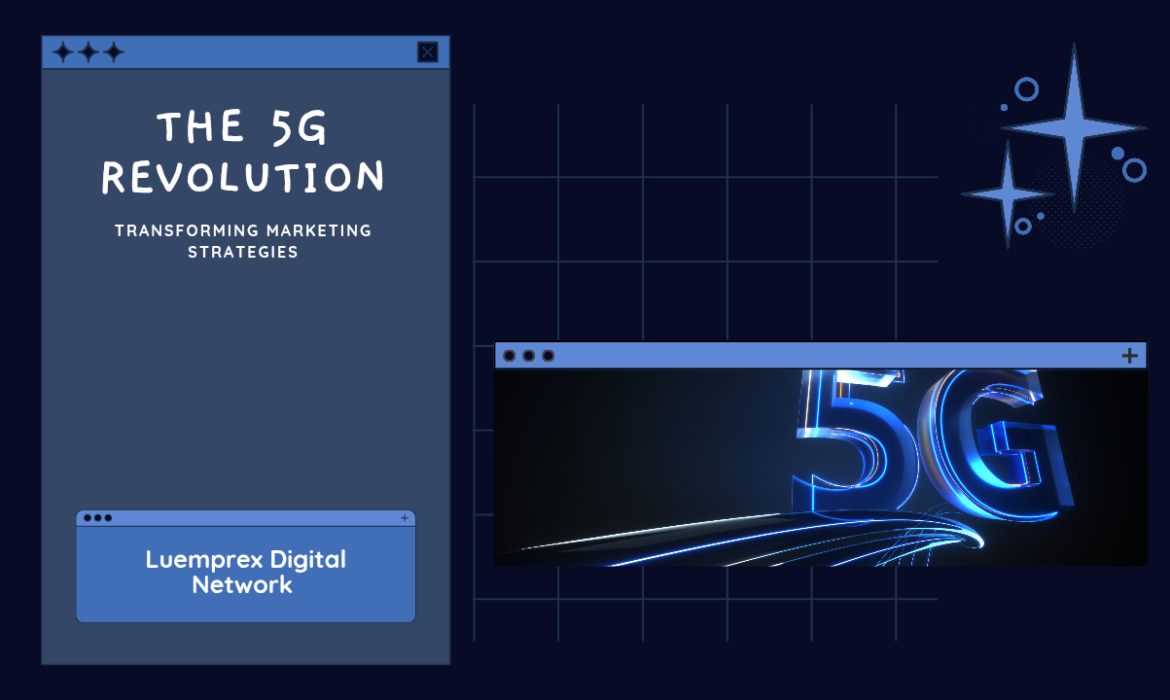081-4797-7173
The world of digital marketing is constantly evolving, and one of the most significant shifts on the horizon is the rollout of 5G technology. With 5G networks gradually becoming available across the globe, it promises to revolutionize various industries by delivering faster speeds, lower latency, and the ability to support more connected devices simultaneously.
But what does this mean for digital marketing strategies? How will 5G reshape the way businesses engage with their audiences? In this article, we will explore the impact of 5G on digital marketing strategies and what businesses need to do to stay ahead.
Understanding 5G and its Capabilities
Before diving into its impact on digital marketing, it’s essential to understand what 5G technology is and how it differs from its predecessors.
5G is the fifth generation of mobile network technology, following 4G LTE. While 4G was a significant leap forward in terms of speed and connectivity, 5G offers:
- Increased Speed: 5G is expected to deliver download speeds up to 100 times faster than 4G, with peak speeds potentially reaching 20 gigabits per second.
- Lower Latency: 5G’s latency, or the delay between sending and receiving data, is significantly reduced. This means near instantaneous communication, making real time interactions much more effective.
- Higher Capacity: 5G can handle millions of devices per square kilometer, which means the Internet of Things (IoT) can expand on a massive scale.
- Improved Reliability: The technology offers more stable connections, reducing the chance of dropped calls or interruptions.
With these capabilities, 5G will unlock new possibilities in digital marketing by providing faster, more reliable, and interactive experiences for consumers.
The Impact of 5G on Digital Marketing Strategies
1. Enhanced Mobile Experiences
With mobile traffic already dominating internet usage, 5G will further amplify the importance of mobile marketing. As more consumers rely on smartphones for browsing, shopping, and interacting with brands, businesses must prioritize mobile-optimized content. The faster speeds and reduced latency of 5G will allow businesses to offer richer, more immersive mobile experiences.
For example, marketers will be able to deliver high-definition videos, interactive elements, and AR (augmented reality) content on mobile devices without worrying about lag or buffering. This opens up new possibilities for marketers to create engaging and visually appealing content that captivates users’ attention.
What You Can Do: To take advantage of 5G, ensure that your website and marketing materials are optimized for mobile users. Implement mobile-first strategies and create content that uses rich media formats like 4K videos and interactive AR experiences.
2. More Interactive and Immersive Content
One of the most exciting possibilities of 5G is the ability to deliver immersive content experiences. Augmented reality (AR) and virtual reality (VR) have long been buzzwords in marketing, but the slow speeds and high latency of previous networks made it difficult to deliver these experiences at scale. With 5G’s faster speeds and lower latency, the barrier to implementing AR and VR marketing strategies will be drastically reduced.
For instance, brands can offer virtual try ons for fashion, beauty, and furniture products. Automotive companies could let customers take virtual test drives, while real estate agents might provide virtual home tours. These immersive experiences create more engagement by allowing customers to interact with products and services in a deeper and more meaningful way.
What You Can Do: Start experimenting with AR and VR technologies in your campaigns. Offer virtual product demonstrations, interactive brand experiences, or live streamed events with 360 degree views. The goal is to create experiences that engage users on a sensory level.
3. Improved Real Time Marketing and Personalization
5G will also enhance the effectiveness of real time marketing and personalization efforts. With ultra low latency, businesses can send and receive data in real time, enabling them to deliver more personalized and timely messages. For example, a retail store could send a personalized discount or promotional offer to a customer’s smartphone as they walk near the store, based on their location and past behavior.
Moreover, 5G’s ability to handle large amounts of data quickly will make it easier for businesses to process customer data in real time and adjust marketing campaigns on the fly. This increased speed and data processing power will allow for even more precise targeting and segmentation.
What You Can Do: Invest in real time analytics and personalization tools to deliver timely offers, updates, and content based on your audience’s behavior. Utilize location based targeting and triggers to provide a more tailored experience for each user.
4. Better Integration with the Internet of Things (IoT)
The Internet of Things (IoT) refers to the interconnected network of devices, such as wearables, smart home products, and other connected gadgets. 5G’s enhanced capacity and speed will support the growth of IoT, and as a result, it will open up new channels for digital marketers.
For instance, brands can use IoT devices to gather data about consumer behavior and preferences. Smart refrigerators could send reminders to users about grocery items they’re running low on, while wearables could track a user’s fitness progress and suggest relevant products or services. The ability to connect with users through various IoT devices will create more touchpoints for marketers to engage their audiences.
What You Can Do: Explore opportunities to integrate your marketing efforts with IoT devices. Consider creating smart products that can offer real time notifications or personalized recommendations, based on data gathered from connected devices.
5. Enhanced Video Content and Streaming
With 5G’s ultra fast download speeds, video marketing will become even more powerful. Consumers will be able to stream high definition video content on their mobile devices without buffering or lag. This means that marketers can focus on creating high quality video content, such as product demonstrations, tutorials, webinars, and live streaming events, without worrying about connectivity issues.
Moreover, the ability to stream and consume high quality video content on mobile devices will encourage more businesses to embrace video as a central part of their marketing strategy. Videos will become even more engaging and immersive, driving higher user engagement and conversion rates.
What You Can Do: Invest in video content creation and live streaming. Experiment with long form videos, short form video ads, and interactive live sessions that engage viewers in real time. The possibilities for video marketing will expand as 5G becomes widely available.
6. Enhanced Data Collection and Analytics
5G networks will provide a massive amount of data that can be used to fine tune digital marketing strategies. With faster speeds and higher capacity, businesses will be able to gather more comprehensive data on consumer behavior, preferences, and interactions across multiple touchpoints. This wealth of data can be used to optimize campaigns, improve targeting, and enhance the overall customer experience.
Additionally, the reduced latency will allow marketers to receive insights in real time, making it easier to make quick adjustments to campaigns and respond to customer needs as they arise.
What You Can Do: Invest in advanced analytics tools to harness the power of 5G data. Use this data to improve your targeting, refine your messaging, and deliver more personalized experiences to your audience.
Conclusion
The advent of 5G is set to revolutionize digital marketing by providing faster speeds, more reliable connections, and the ability to support more connected devices. This will open up new opportunities for businesses to engage their audiences through immersive content, real time personalization, mobile experiences, and much more.
To stay ahead of the curve, digital marketers should embrace the potential of 5G by investing in technologies such as AR, VR, and video content. They should also prioritize real time marketing, leveraging data and analytics to deliver more personalized and timely campaigns.
By adapting to the changing digital landscape, businesses can leverage 5G to create more engaging, effective, and data driven marketing strategies that will drive growth and success in the coming years.
0






